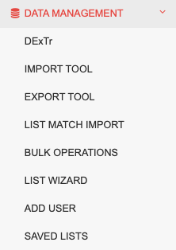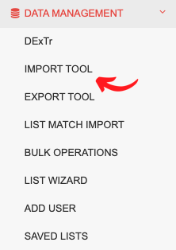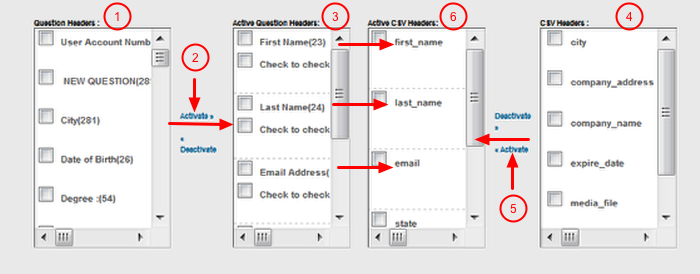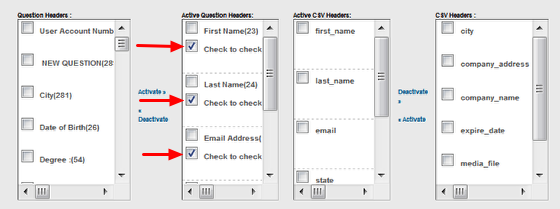Import - How to Create an Import Mapping Template
This lesson describes how to create an mapping template to be used during the import process. Detailed instructions on importing a file into the ONEcount system are found in the "How to Import a File" lesson.
Please refer to the User Operations Quick Start Guide for important information about basic concepts and rules relating to imports and bulk operations.
OPEN THE "DATA MANAGEMENT" WINDOW

Click on "Import Tool" in the sub-menu.

This will open the Import window, as shown below.

CREATE THE MAPPING TEMPLATE
1. In the Import window click on "Browse" (1), search for and select your import list, and select "Upload File" (2).

You have three options when creating a template:
1. Create Mapping then Import List - Create a template and continue with the import.
2. Create Mapping Only - Use the same import list to create mapping template(s) without continuing with an actual import.
3. Create Mapping Only - Use different list(s) with different fields to create template(s) without continuing with an actual import.
Complete Step 2 only if you plan on continuing with the import after creating the import mapping template.
If you plan on using the same import list to create multiple templates without proceeding with actual imports as you complete each template, complete Step 1 then move on to Step 3.
If you plan on using a different list(s) with different fields to create multiple templates without proceeding with imports as you complete each template, complete Step 1 then move on to Step 3.
2. If you plan to proceed with an import after creating the import template, give your import an Import Title (1), Import Description (2), select a Source Code if using one (3), select the product(s) from the Product List (4), and select a Product Status (5).

You can select multiple products by holding down the CTRL (PC) or CMD (MAC) key when clicking on a product name.
Below the Product List, you will see a list of any existing Import Mappings (templates), if any.

To modify an existing template, select "Use". The Template Description should provide you with a description of the template.
To delete an existing template, select "Delete".
3. Proceed to the mapping section and map your fields (either from scratch for a new template or by modfying an existing template).

To map fields:
- Select data fields/questions to map from the ONEcount database (1) then select "Activate" (2). Selected questions/data fields will appear in the "Active Question Headers" column (3). (Move from left to right.)
- Select the data fields/columns to map from the CSV import file (4) then select "Activate" (5). Selected data fields/columns will appear in the "Active CSV Headers" column (6). (Move from right to left.)
To move more than one field at a time into the "Active Header" box, select multiple fields then click on "Activate".
To remove a field from the Active column, select the field and click on "Deactivate". Be sure to remove the same field from the other Active column.
When mapping fields, Active Question Headers and Active CSV Headers must match, ie the fields must bbe in the same order. (See purple arrows in screenshot above.)
Question Header and CSV Header field names don't need to be identical, e.g. a Question Header may be "Email Address" and CSV Header "Email".
If you plan on completing an import after creating the template, select field(s) against which to check for duplicates.
3a. Select fields to check duplicates against.

ALWAYS BE SURE TO CHECK FOR DUPLICATES. IF YOU DON'T, DUPLICATE RECORDS WILL BE ADDED TO THE ONECOUNT DATABASE.
When saving a mapping template, only the Active Headers will be saved. Fields to check for duplicates WILL NOT be saved.
3b. If proceeding with an import, set Request Date field, Expiration Date field, and Media Files fields (all optional).

Select the column in your import file to set the Request Date (1), select expiration date field to specify expiration date (2), select the column with media file filenames/paths to link media files (3).
SAVE THE MAPPING TEMPLATE
4. Review mapping and selections, then click "Set" at the bottom of the page.

When "Set" is clicked on, the three buttons below will appear.
5. Select "Save Mapping Template".

When saving a mapping template, only the Active Headers will be saved. Fields to check for duplicates WILL NOT be saved.
To proceed with the import without saving the mapping template, select "Import" (2).
To change the import mapping without importing, select "Reset" (3).
6. After selecting "Save Mapping", a pop-up window will appear. Give the template a title (1) and description (2), then click Save" (3).

In order to easily identify templates, especially if you have multiple templates, it is a good idea to be as descriptive as possible with the template title and description.
7. When you select "Save", you will be brought back to the mapping screen where you will see your new template at the bottom of the list of existing Import Mappings (Templates).

8. You have successfully saved your import mapping template!
If proceeding with an import, select "Import" below the mapping section (all of the mapping from creating the template will be in tact).
To create a new import mapping template using the same import file, refresh your browser and follow steps 4-7 above.
To create a new import mapping template using an import file with different fields, follow steps 1-7 above.
Search All Documentation:
Unknown macro: livesearch. Click on this message for details.
The [livesearch] macro is not in the list of registered macros. Verify the spelling or contact your administrator.
Search USER OPERATIONS Documentation:
Unknown macro: pagetreesearch. Click on this message for details.
The [pagetreesearch] macro is not in the list of registered macros. Verify the spelling or contact your administrator.
More USER OPERATIONS Documentation
Click here to expand...
Add Users
How to Use an Import Mapping Template
Batch Operations
Bulk Operation - How to Perform a Batch Delete
Bulk Operation - How to Perform a Batch Product Change
Bulk Operation - How to Perform a Batch Status Change
Bulk Operation - How to Perform a Batch Suscribe
Bulk Operation - How to Perform a Batch Unsubscribe
Bulk Operation - How to Perform a Merge of Duplicate Users
Target Audience Segments
